ACAM
is a new high-throughput imager/spectrograph, permanently mounted at
a folded-Cassegrain focus of the WHT.
The field of view in imaging mode is 8 arcmin (0.25 arcsec/pixel).
A set of U B V R I Z filters is available by default,
but almost any of ING's filters
(including the TAURUS narrow-band filters)
can be mounted in ACAM.
Low-resolution spectroscopy over ~ 3500 - 9000 A is provided by a
VPH disperser.
For 0.5- and 1.0-arcsec slits, the on-axis spectroscopic resolutions
at 6000 A are R ~ 450 and 900 respectively.
Observers may apply for
service or
scheduled time
with ACAM in the usual way.
ACAM was designed in-house, and the project was delivered in collaboration
with Kevin Dee of Engineering and Project Solutions Ltd.
Below are a few images and spectra taken during, or soon after,
the successful on-sky commissioning of ACAM 2009 June 9 - 12.
The images are oriented with N up, E to the
left, unless otherwise stated:
As of October 2009, ACAM has been used to obtain data for ~ 12
science programmes. The first publication in a refereed
journal, based in part on data from ACAM, is:
"Data mining for dwarf novae in SDSS, GALEX and
astrometric catalogues" by Wils et al (2009),
see under 'dwarf novae' below .
Spiral galaxy M51 (the Whirlpool galaxy)
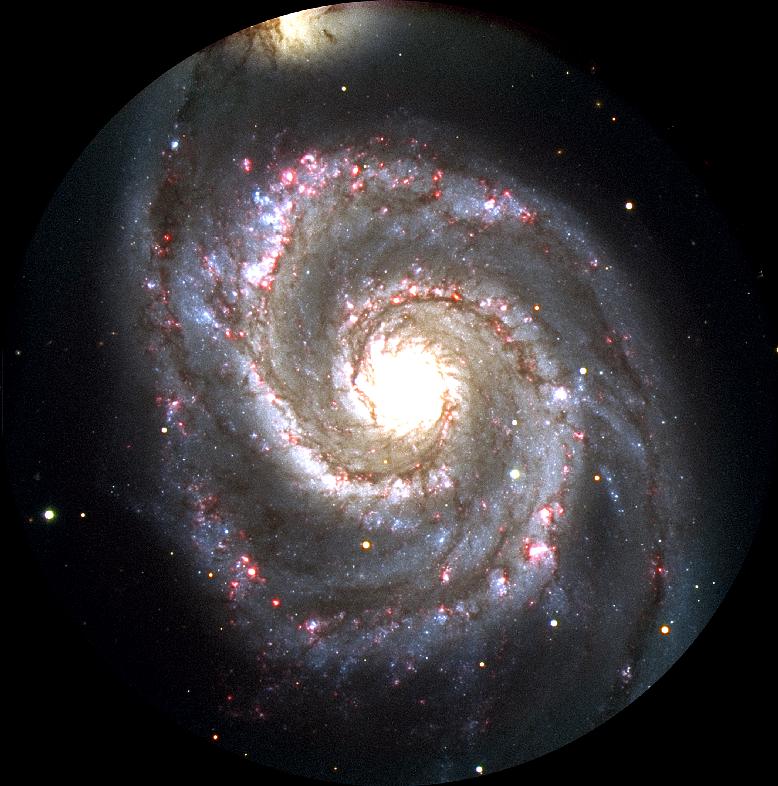 This is a composite of images through B, V, R and Hα
filters.
Exposure times: B 520 sec, V 330 sec, R 250 sec, Hα 900 sec.
Click on the image for the full-size version(3.4 Mbytes).
This is a composite of images through B, V, R and Hα
filters.
Exposure times: B 520 sec, V 330 sec, R 250 sec, Hα 900 sec.
Click on the image for the full-size version(3.4 Mbytes).
Pablo Rodríguez-Gil, Chris Benn, Andrew Cardwell
Back to top
The moon
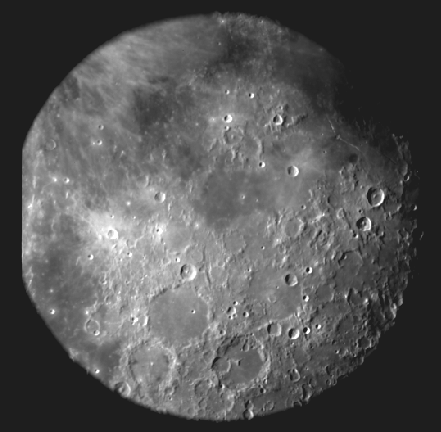
The image is centred
near the zero of lunar coordinates,
with N up, E left (lunar N is ~ 15 deg right of up).
The dark area just above the
centre is the Sinus Medii (a small mare).
The prominent crater with a
central boss,
slightly left of and below centre, is Herschel,
diameter 45 km (140 ACAM pixels).
The image was taken
through a narrow-band
(5045-A) filter (and cloud!), with an exposure time ~ 0.1 sec.
Chris Benn
Back to top
Unusual cataclysmic variable star MV Lyr
This is the first-light spectrum of a science target:
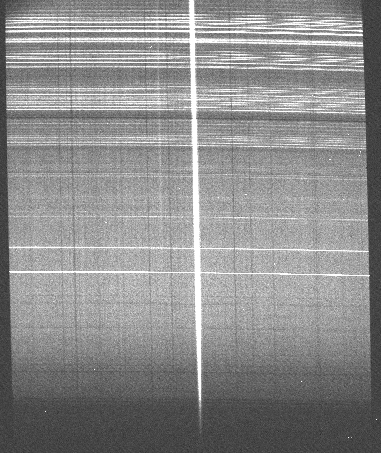
Extracted spectrum:
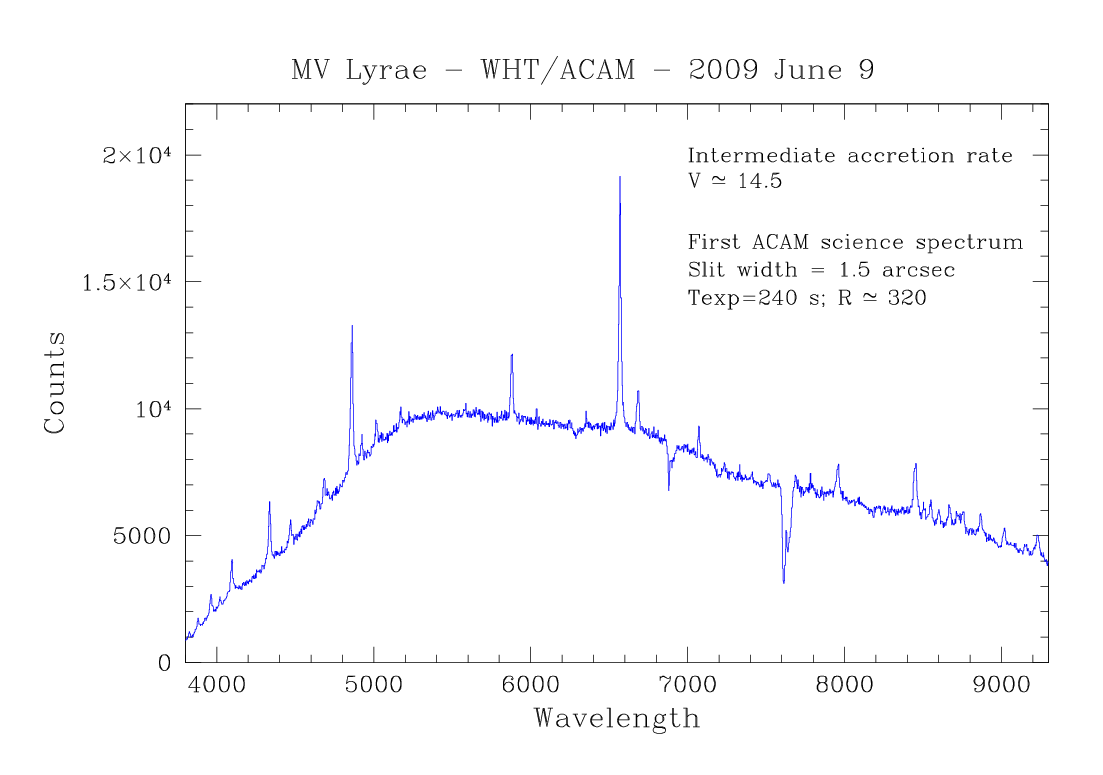
The brightness of cataclysmic variable MV Lyrae varies dramatically between two levels (low state and
high state), depending on the
accretion rate from the donor star to the white dwarf.
Recently, it has entered a very unusual intermediate state.
This is the first spectrum obtained of the star in this state.
Pablo Rodríguez-Gil
Back to top
Interacting galaxies NGC 5953 / 5954
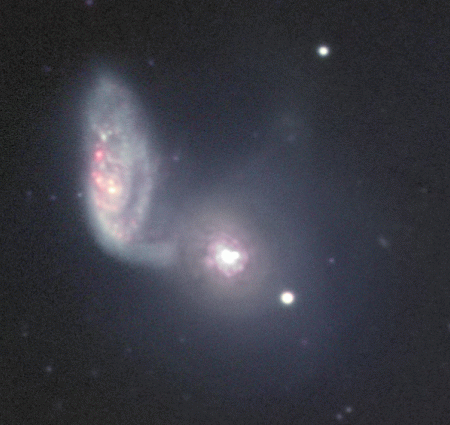
This image of the interacting galaxies NGC 5954 (left) and NGC 5953
(right) was created by combining images taken through V and R broad-band
filters, and through [OIII], Hα and S[II] narrow-band filters,
with red colour highlighting regions of Hα and [SII] emission.
The image is ~ 2 arcmin across.
Both of these galaxies,
located at a distance of some 25 Mpc (megaparsec), host an active galactic
nucleus (AGN).
NGC 5953 has been classified as morphological type
SAa, whereas NGC 5954 is an SABcd galaxy.
The strong patchy line emission
is a result of both the active nuclei and of
the massive star formation, stimulated by the galaxy-galaxy
interaction.
This image was obtained as
part of a study of how episodes of massive star formation are
triggered by gravitational interactions between galaxies.
Click on the image to see more of the field.
Johan Knapen (IAC), Nik Szymanek
Back to top
Nova V458 Vul
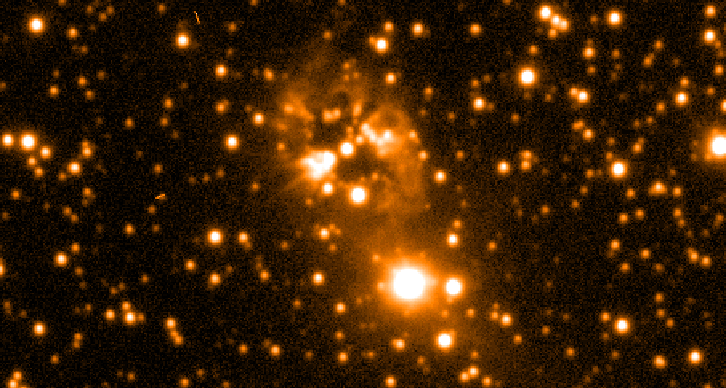 The binary progenitor of nova V458 Vul is surrounded by a
planetary nebula, shown in the above 1500-sec image through an
Hα filter.
The binary progenitor of nova V458 Vul is surrounded by a
planetary nebula, shown in the above 1500-sec image through an
Hα filter.
The aim of the observations is to measure
accurately the distance to the nova.
This can be done by monitoring how the ionisation front caused by the nova
explosion ionises the planetary nebula, i.e. by light-travel
considerations.
With an accurate distance, the evolutionary status of
the stars forming the progenitor binary system can be explored.
This
is important, as only one other nova has been witnessed to explode
within a planetary nebula, GK Persei.
However, it's not yet certain that
GK Persei is actually a planetary
nebula.
Boris Gaensicke (Univ. Warwick), Pablo Rodríguez-Gil
(ING/IAC), Albert Zijlstra (Univ. Manchester)
Back to top
Globular cluster M13
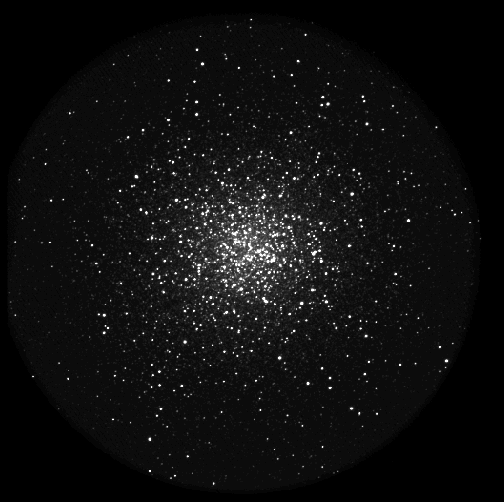 This 0.5-sec exposure through a V filter confirms
that image quality remains good out to large radius.
In fact, in this seeing
(1 arcsec), the point-spread-function of the
images near the edge of the field
is barely distinguishable from that
at the centre of the field.
This 0.5-sec exposure through a V filter confirms
that image quality remains good out to large radius.
In fact, in this seeing
(1 arcsec), the point-spread-function of the
images near the edge of the field
is barely distinguishable from that
at the centre of the field.
ACAM is designed to give excellent imalge quality over most
of the field. At the very edge of the field, the
point-spread-function from the optics is poorer, FWHM ~ 0.5 arcec
(lab measurement, consistent with the ray-tracing prediction).
Back to top
Binary-star eclipse
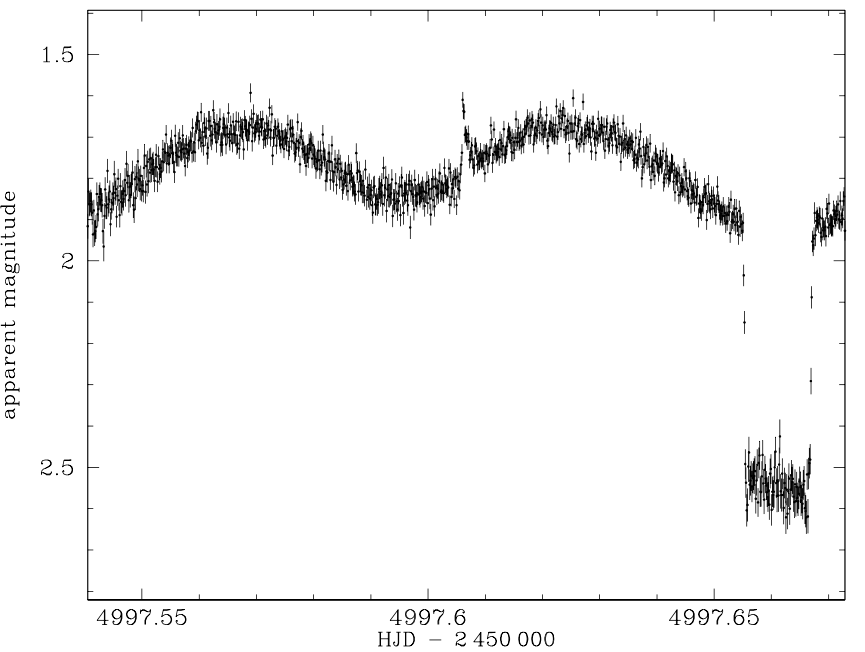
Testing the theory of
stellar structure and evolution relies on
model-independent measurements of masses and radii across the entire
range of stellar masses and evolutionary stages. Such measurements
can be obtained from observations of eclipsing binary stars.
ACAM was used to identify a new, faint (g=20),
eclipsing white dwarf plus M-dwarf binary with an orbital period of
188 min, only the 15th such system known so far. The ingress and
egress of the white dwarf eclipse
last less than a minute, and
resolving these features requires imaging with high time resolution.
The ACAM
observations were obtained with exposure times of 10s. Binning the
camera 2x2 and windowing to a 2'x2' field of view decreases the dead
time to 1.8s.
The light curve illustrates that the white-dwarf
eclipse (at HJD=2454997.66 in the light curve above) is clearly resolved.
The sinusoidal shape of
the out-of-eclipse light curve is related to the non-spherical shape of
the M-dwarf in this short-period binary. A flare is detected at
HJD=2454997.61, indicating stellar activity on the M-dwarf. These
observations demonstrate that ACAM on the WHT opens a new window into
fast photometry of faint objects.
Boris Gaensicke (Univ. Warwick),
Pablo Rodríguez-Gil (ING/IAC)
Back to top
Planetary nebula M1-75
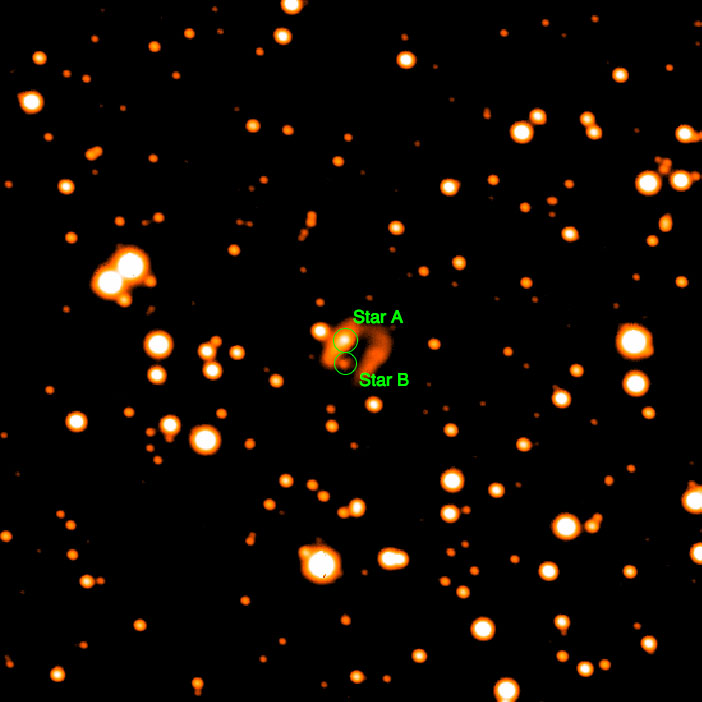
Among the many mysteries posed by the planetary
nebula (PN) M1-75, one of the most striking is the apparent lack of
a central star.
The ACAM image above was taken through an I-band filter,
minimised the contribution from the emission line nebula with respect
to any central star candidate, and revealing star A (I ~ 19.5),
offset from the
geometrical centre of the PN and, 4.5 arcsec away,
star B (I ~ 21.6), much fainter, but centred.
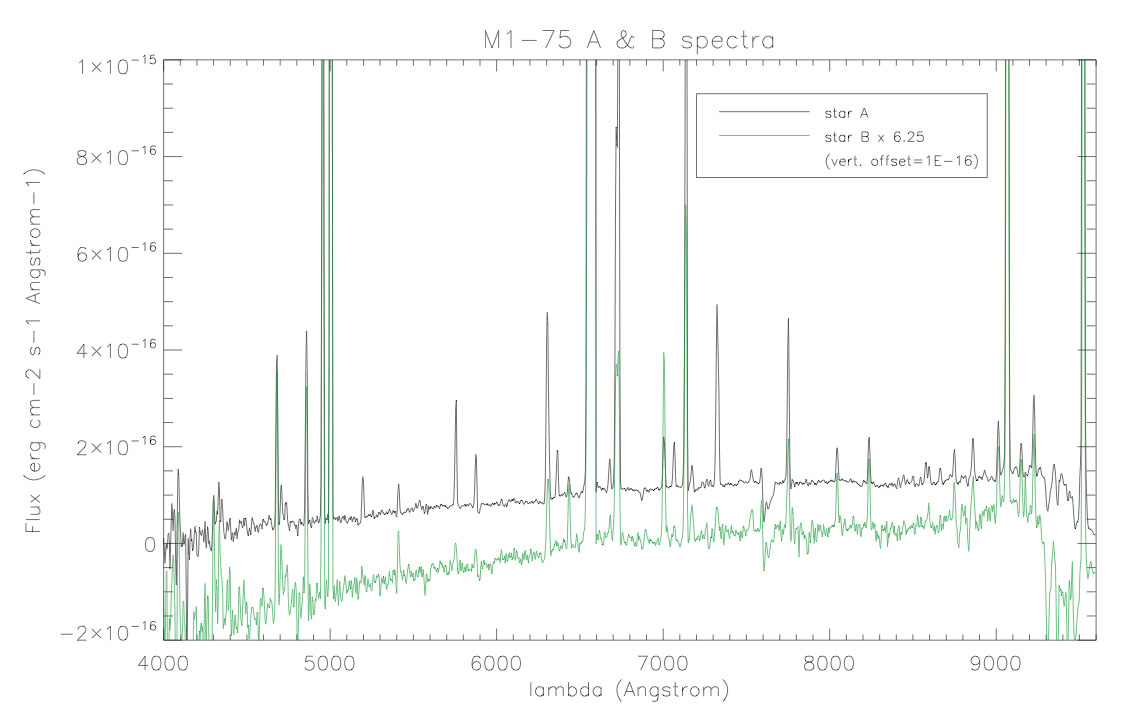
The extracted spectra of stars A and B (plus the unremovable PN)
are shown above.
Although further analysis is needed, star A seems
slightly bluer (i.e. hotter), and the nebula around it seems brighter.
Togther, these observations suggest that star B could be
the (offset) central star of PN M1-75.
Miguel Santander
Back to top
Search for dwarf novae
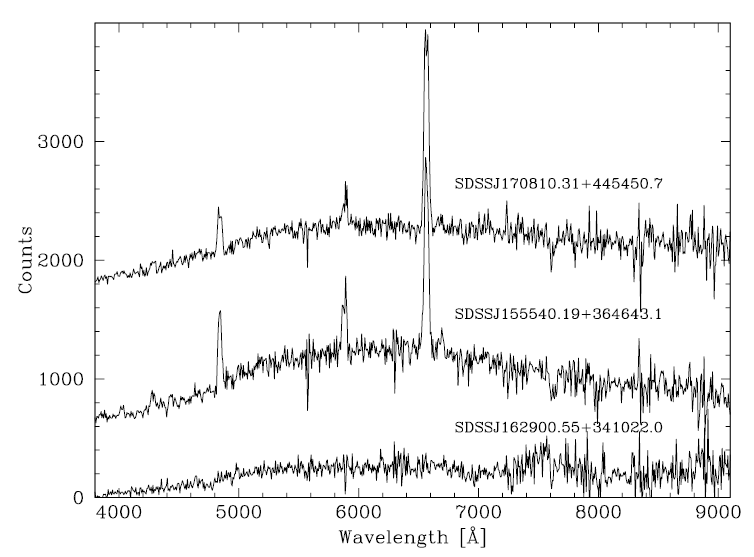
Wils et al (2009), astro-ph/0910.3218
Back to top
ACAM team celebrating first light, 2009 June 9
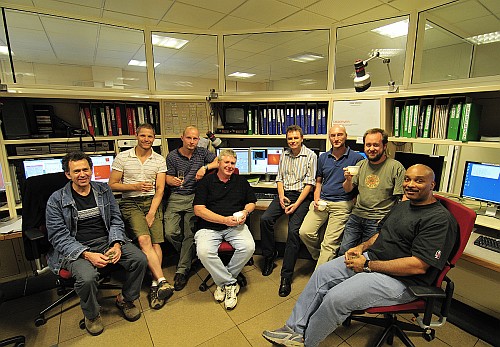
Click on the image for a larger version (400 kbytes).
From left to right: Carlos Martin, Craige Bevil, Tibor Agocs, Kevin Dee,
Chris Benn, Andrew Cardwell, Pablo Rodriguez, Don Abrams.
Other members of the ACAM team are listed on the
ACAM team
page.
Photo credit: Pablo Rodriguez.
Back to top

